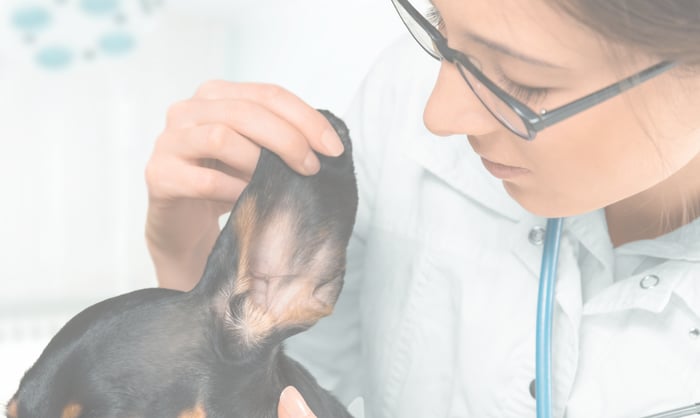If you’re like most pet parents, checking your dog’s ears for signs of infection isn’t on your daily to-do list – and that’s okay!
Thankfully, most dogs are pretty darn good at letting us know when something’s wrong with their ears. The obvious signs of infection – persistently scratching at the ears or shaking the head – are both easy to recognize and hard to miss.
But some dogs are more subtle about their bothersome ears. Signs like a subtle head tilt, one ear being held in a different position, or one pet obsessively licking the others’ ears can also hint at a brewing infection.
How can you tell when your dog really does have an ear infection – and what should you do if you suspect dog ear infection? Read on for advice from veterinarian Dr. Stephanie Malmquist on recognizing and treating ear infections in dogs.
👂 How do I check my dog for an ear infection?
If you think your dog’s ears are bothering them, take a peek! Many signs of an ear infection are easily spotted with a close look.
There’s a good chance your dog has an ear infection if you notice symptoms like:
- Ear redness.
- Excessive ear debris.
- Foul odor.
- Ear skin is excessively warm.
- Ears seem painful to touch.
❓ What causes ear infections in dogs?
Many pet parents assume ear infections are caused by bacteria or yeast from their dog’s environment. However, the bacteria and yeast found in canine ear infections are usually an overgrowth of the normal microorganisms on your dog’s skin.

More often, ear infections (and skin infections) result from a disruption or imbalance of the skin barrier. When this happens, the body’s natural defenses against infections are altered – which can cause bacterial or yeast infections.
These disruptions or imbalances can be caused by many different things. Too much debris or hair in the ear canal, sensitivities like food or environmental allergies, conditions like lupus or hypothyroidism, excessive moisture from water exposure, and incorrect ear cleaning (or over-cleaning) are all potential starting points for an infection.
🏥 How do I prevent Dog Ear Infection?
Preventing Dog Ear Infections can be tricky! A lot depends on the infection’s underlying cause.
If your pup is a frequent swimmer, their ear canals are staying moist for too long post-dip. Regular application of a drying flush might be helpful if post-swim infections are showing up. Talk to your vet about which solution is best for your dog.

If your pup loves to get dirty, produces excessive ear wax, or has excessive hair growth in the ear canals, extra cleaning and grooming may help prevent infections. Stay on top of baths and talk to your groomer about what might help keep your dog’s ears clean and healthy.
If the problem is caused by the structure of your dog’s ear canal, allergies, or a medical condition, your veterinarian can help you to identify and manage the issue.
And whatever the cause of your dog’s ear infection, your vet should be able to provide your pup some relief by treating for infection, pain, and inflammation. Soon they’ll be good as new!
Stay healthy, stay happy, stay curious #healthygang!
Lots of love,

- Dr. Steph Malmquist, DVM & the healthybud team
DISCLAIMER: The information presented here is not meant to replace your vet’s advice or prescribed medications, but only to suggest additional options to explore, based on your dog’s condition.
Support your best bud’s health with high quality, healthy foods and treats you will both feel great about. Visit the healthybud website now to learn more about our products and subscription options.






